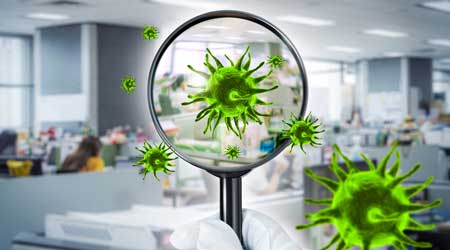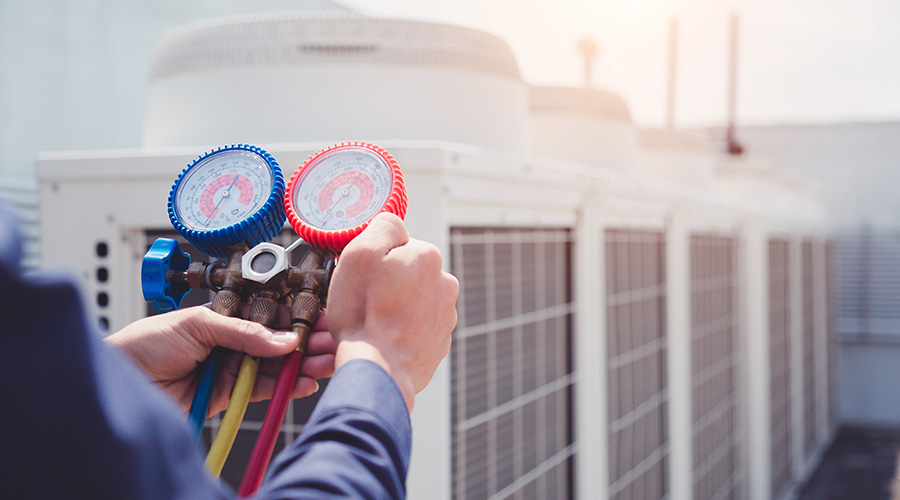3 Strategies to Prevent HVAC from Spreading Airborne Coronavirus
Good ventilation, filtration, and humidity control strategies are crucial to mitigating the spread of airborne coronavirus in facilities.
Protocols keeping people safe from COVID-19 have been implemented at facilities throughout the world. Some of these changes have been regulated by governments, but far more have been implemented by organizations trying to take the best information they have and put it into practice. There is an overwhelming body of data suggesting that face masks, social distancing, and hand washing are proven steps to help mitigate the risk of COVID-19 spread. However, these steps alone are not enough.
In July, the scientific community spoke up through an open letter to the World Health Organization (WHO) citing multiple references to the fact that COVID-19 can spread via airborne transfer, particularly through very small particles known as aerosols. These particles can be suspended in the air for several hours according to these experts.
So, what have you done to ensure people are getting clean air and minimizing the risk of community virus transfer in your facility? Have you been bombarded with technologies and quick fixes from vendors to ‘eradicate the virus’? What strategies have you found work best? No matter what you’ve tried so far, the answer is to rely on proven solutions and technologies that have a long track record of being effective. Here are a few of those strategies.
Best Ventilation Practices
First, increase your ventilation. Opening your windows will help, but for many this is not a practical solution. Instead, you can adjust your building controls to increase the amount of outdoor air flowing through your system. ASHRAE and others have suggested a two-hour flush prior to occupants arriving in the morning. The whole concept here is to bring in fresh air, thereby diluting the recirculated and potentially virus-laden, indoor air.
Understanding the number of air exchanges your HVAC system is capable of is another critical component. You could have 100 percent outdoor air, but if it only changes over every 90 minutes, then your occupants are potentially and unnecessarily at risk because of the slow reduction of any aerosols hanging in the air.
Some will need to consider adjunct solutions to increase the amount of outdoor, or make-up, air. Beyond your existing HVAC system, there are Dedicated Outdoor Air Systems (DOAS) that can provide up to 100 percent outdoor air. These systems can be deployed as roof top units, stand-alone units, or integrated in individual rooms in the ceiling space.
Minimum Filtration Required
Most filtration conversations begin with the HVAC system, and this is one place where a change in filtration is a practical solution. However, in many cases HVAC systems have some natural limitations. How many air exchanges occur per hour, how evenly are these air exchanges occurring in and around your occupants, and in some cases, how often is your HVAC system running. These are questions you should consider when determining how to keep the air each occupant is breathing as clean and comfortable as possible.
Augmenting your filtration with local air purifiers may be the most effective way of ensuring clean air for your occupants, while also providing a visual cue to people to help them know they are being protected. Helping people “see” that their air is being protected is a component of their safety, a basic human element needed to perform a multitude of other tasks.
Localized air purifiers (or scrubbers), typically allow for more air exchanges, closer to your occupants. Look for devices that provide a minimum of HEPA grade filtration. This is where many are being bombarded by vendors with quick fix answers and big claims around virus reduction. Buyers beware. Many of these technologies have less-proven track records and can compound their claims beyond what you are really buying. Starting with HEPA filtration is a fool-proof way to ensure you are getting a very high-performance particulate filtration in these localized spaces. Solutions that layer molecular filtration or other forms of proven science in addition to HEPA should be considered preferred based on their effectiveness and their known ability not to have other, unwanted, outcomes. For example, some technologies, like ionization and photocatalytic oxidizers, can create unwanted intermediate molecules like formaldehyde and ozone, which worsen your indoor air hygiene. Needless to say, in any of these products that claim viral inactivation, look for third-party laboratory data and investigate how closely the testing measures up to ‘real world’ applications.
Virtually every HVAC system has an existing filtration component, partly to protect the equipment from debris, but also to protect the quality of the air your occupants are breathing. Given the inherent risk of the HVAC system circulating the virus, it makes good sense to require an audit of the installation and efficiency of the filtration you are using. Filters with minimum efficiency reporting value 15 (MERV 15) and above have outstanding capture rates (at least eighty-five percent for 0.3-1.0 micron particles). However, this level of particulate filtration results in far more resistance to airflow, and you should determine how much resistance your system can handle. At a minimum, MERV 13 filtration (50 percent for 0.3-1.0 micron particles) is recommended by ASHRAE.
In addition, some solutions exist whereby you can add filtration to the return system. As air is evacuated from a room, adding a filter ensures the spread of any local particles is limited to that one room and not carried further into the ducting of your HVAC system. While this solution is not always practical, it is something to consider.
Relative Humidity
Humidity control is the last piece of the puzzle. Most of us already have a handle on humidity control, because, along with temperature, it is one of the primary air quality conditions that occupants can “feel” (and complain about). Viruses and bacteria also ‘feel’ relative humidity and prefer the extremes of very dry or very moist conditions. The recommendation is that relative humidity (RH) be maintained between forty to sixty percent to minimize the environments where these pathogens thrive.
While this may seem straightforward, many are challenged with bringing in additional outside air and keeping up with humidity and temperature control. Dehumidification, particularly in warmer climates may need to be augmented in your facility to ensure RH is controlled in an energy-efficient manner.
Clean air matters. Taking proven actions to manage your basic indoor air hygiene practices will help minimize the risk of COVID transmission and keep your occupants feeling good about their environment.
Kris Howard is the President of Madison Indoor Air Hygiene, leading its Solution Team.
Related Topics:












